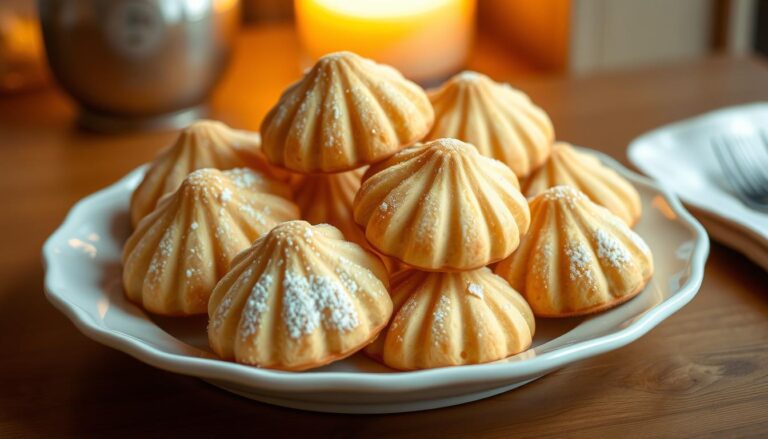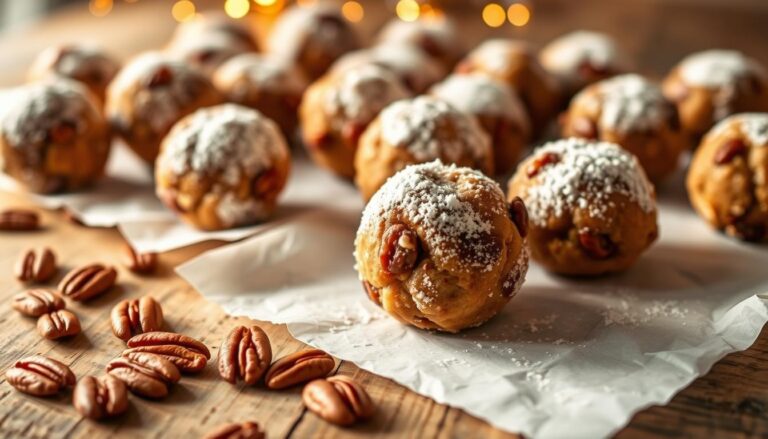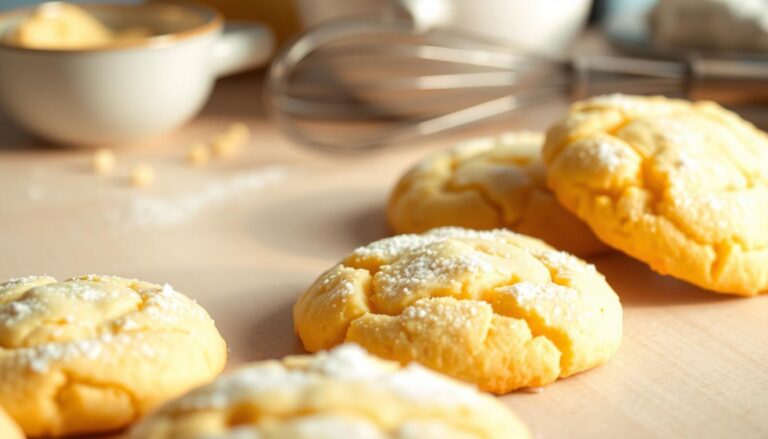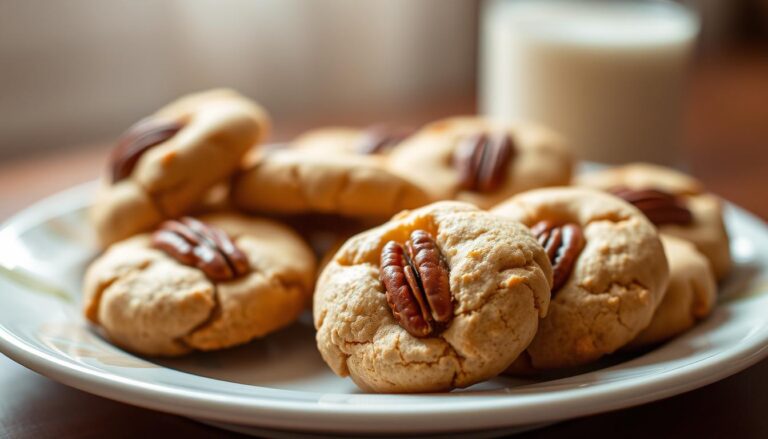How to Make Classic Anise Cookies: A Step-by-Step Guide
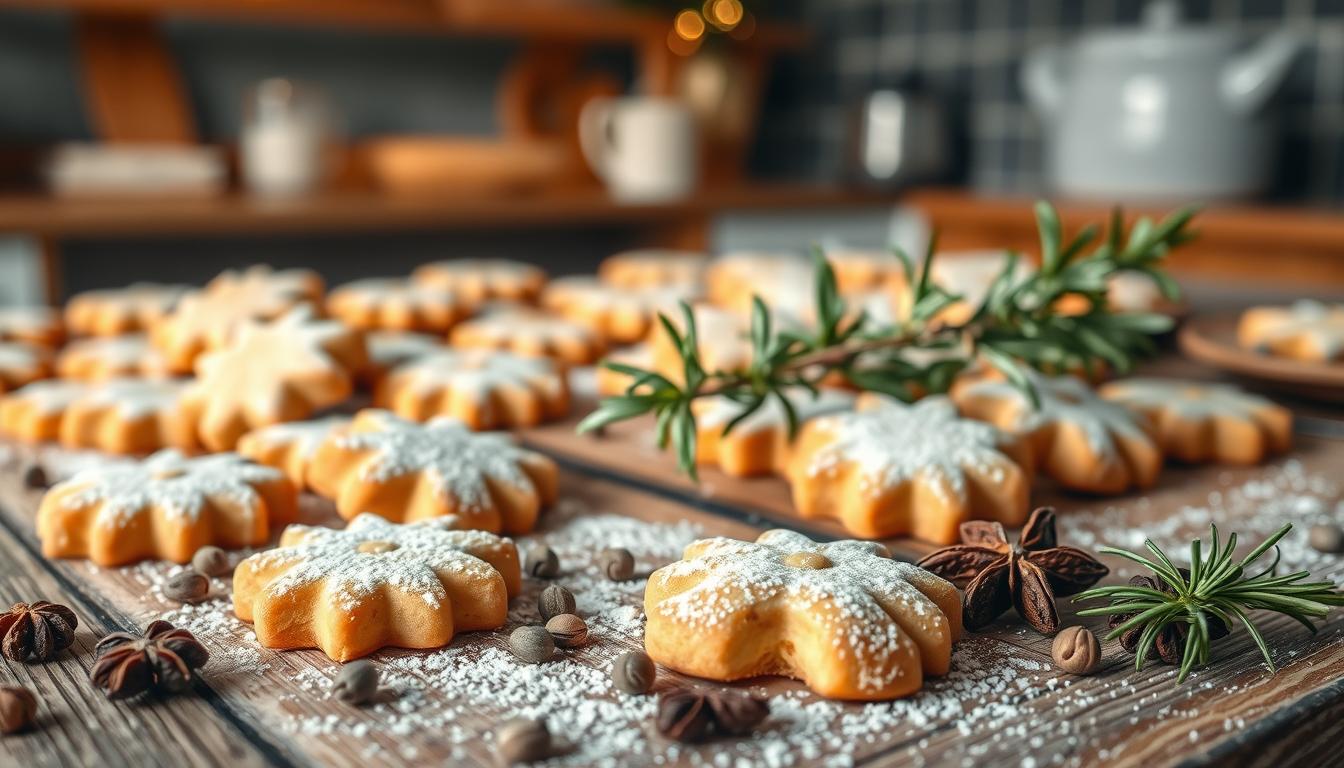
The smell of anise cookies in my grandmother’s kitchen brings back childhood holiday memories. These cookies are more than treats; they’re a way to connect generations through baking. They bring joy and warmth to our celebrations.
Anise cookies are not just desserts; they’re a tradition that unites families. They create moments of connection and nostalgia. This guide will help you make perfect anise cookies, starting a new family tradition.
Making anise cookies is more than following a recipe. It’s about making memories, honoring traditions, and sharing love. It’s a way to connect with others through delicious homemade treats.
Key Takeaways
- Anise cookies are a beloved holiday baking tradition
- The recipe requires simple ingredients found in most kitchens
- Proper technique is crucial for achieving perfect texture
- Decorating allows for personal creative expression
- These cookies make excellent gifts and party treats
Understanding Classic Anise Cookies and Their History
Anise biscuits take us on a tasty trip through history. These Italian treats hold deep cultural value. They link families across generations with their special taste and treasured recipes.
The history of anise cookies goes back to ancient times. Spices were key in food and rituals. Pizzelle, an old cookie from Abruzzo, Italy, started in the 8th century. It kicked off a long tradition of baking.
Origins of Italian Anisette Cookies
Italian immigrants brought these recipes to America. They made anise cookies a favorite at family events. The unique taste comes from anise seeds, first grown in Egypt.
- Anise has been used in baking for thousands of years
- Trade routes introduced the spice to medieval European kitchens
- Each region developed unique variations of anise cookies
Traditional Holiday Significance
Anise cookies are more than desserts. They stand for joy, celebration, and family history. At festivals and special times, they symbolize cultural identity and shared memories.
Cultural Impact on Modern Baking
Today, bakers keep traditional recipes alive while adding new twists. From Italian biscotti all’Anice to Mexican Cookies de Anís, anise cookies show how traditions evolve.
Baking these cookies connects us to generations of family history and cultural roots.
Essential Ingredients for Perfect Anise Cookies
Making delicious licorice cookies begins with the right ingredients. Your anise extract is the key to their unique taste. To achieve a memorable flavor, you need a mix of important ingredients.
Here are the essential ingredients for your anise cookies:
- Flour: 3 cups of all-purpose flour provides the perfect base
- Baking Powder: 5 teaspoons to help your cookies rise
- Butter: 8 tablespoons for rich flavor and texture
- Sugar: 3/4 cup granulated sugar for sweetness
- Eggs: 4 large eggs at room temperature
- Anise Extract: 2 teaspoons for that signature licorice cookies flavor
The secret to these cookies is the balance of ingredients. Your anise extract gives them that classic licorice taste. You can also try vanilla or almond extract for a unique flavor.
Pro tip: Make sure all ingredients are at room temperature for the best results. The mix of butter, sugar, and anise extract makes the cookies tender and flavorful.
The secret to perfect anise cookies is in the quality of your ingredients and the love you put into making them!
Kitchen Tools and Equipment Needed
To make tasty anise cookies, you need the right kitchen tools. The right equipment makes baking better and helps you get perfect cookies every time. Whether you’re new to baking or have lots of experience, the right tools are key.
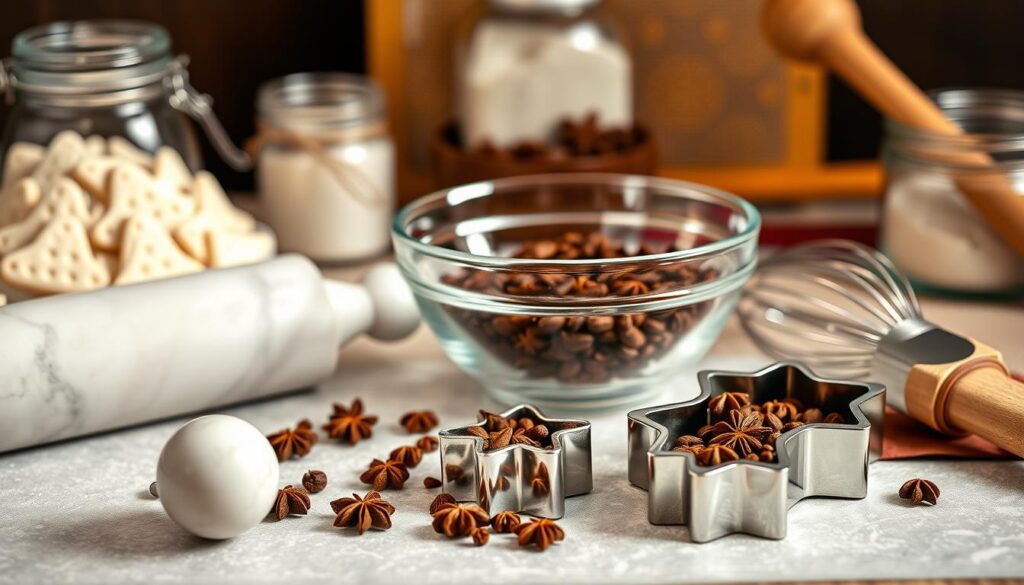
Before mixing your dough, make sure you have these basic baking tools:
Basic Baking Essentials
- Mixing bowls (various sizes)
- Whisk
- Measuring cups and spoons
- Baking sheets
- Parchment paper or silicone baking mats
- Wire cooling rack
Precision Measuring Equipment
Getting your measurements right is important for cookie flavors. Use high-quality measuring tools for consistent results:
- Digital kitchen scale
- Nested measuring cup set
- Measuring spoons
- Tablespoon measure
Optional Specialized Tools
These tools are not necessary but can make baking better:
- Cookie scoop (1½ tablespoon size)
- Stand mixer
- Small mixing bowls for ingredient prep
- Storage containers
Having these tools in your kitchen will help you make delicious anise cookies. They will impress your family and friends.
Preparing Your Workspace and Ingredients
Starting your christmas cookies journey means setting up a tidy workspace. Holiday baking is all about preparation and detail. Before mixing your anise cookie dough, make sure your kitchen is ready for action.
Ingredient Preparation Checklist
- Remove butter and eggs from refrigerator 30-45 minutes before baking
- Measure all ingredients precisely
- Ensure ingredients are at room temperature
- Gather all necessary equipment
Ingredients at room temperature are key for smooth cookies. Cold butter and eggs can mess up the mix.
Essential Equipment for Holiday Baking
| Category | Recommended Tools |
|---|---|
| Mixing | Stand mixer, large mixing bowl, whisk, spatula |
| Measuring | Measuring cups, kitchen scale, measuring spoons |
| Baking | Baking sheets, parchment paper, wire cooling racks |
Professional bakers say preparation is half the battle in holiday baking. Organizing your space and ingredients helps you bake without stress. This way, you can focus on making tasty anise cookies.
Pro Tip: Line your baking sheets with parchment paper for easy cleanup and even baking!
Investing a bit of time in preparation will make baking easier and more fun. Your delicious christmas cookies will be worth it!
Making the Classic Anise Cookies Dough
Creating the perfect dough is key to making traditional fennel seed cookies. Your baking journey starts with understanding how to prepare the dough.
The first step is to gather the right ingredients. Then, you need to master specific mixing techniques. Let’s look at the essential steps to make a flawless anise cookie dough.
Proper Mixing Techniques
Cookie dough preparation needs precision and care. Follow these key steps:
- Soften butter to room temperature
- Cream butter and sugar until light and fluffy
- Add eggs one at a time, mixing thoroughly
- Incorporate anise extract for authentic flavor
Achieving the Right Consistency
The secret to perfect fennel seed cookies is the dough texture. Aim for a soft, slightly sticky dough that holds its shape. Mix gently yet thoroughly.
Troubleshooting Common Dough Issues
Avoid these common pitfalls when preparing your cookie dough:
- Do not overmix the dough, which can make cookies tough
- Use the spoon-and-level method for measuring flour
- Chill dough for 30 minutes to improve texture
- Ensure all ingredients are at room temperature
By following these guidelines, you’ll create a delectable dough. This dough promises delicious anise cookies every time.
Shaping and Forming Your Cookies
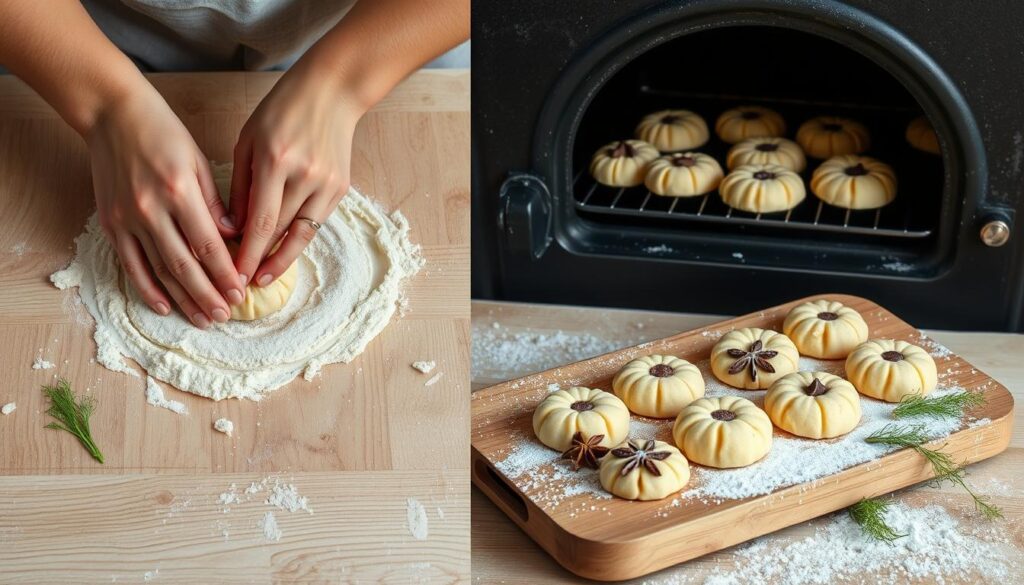
Making the perfect shape for Italian cookies is an art. Your anise biscuits can go from simple dough to beautiful treats with the right techniques. The classic way is to make uniform cookies that show skill and tradition.
When shaping your anise biscuits, consider these key methods:
- Drop dough by tablespoonfuls onto parchment-lined baking sheets
- Space cookies approximately 1 inch apart to prevent merging
- Create traditional figure-8 shapes for authentic Italian cookies
- Experiment with wreath or twisted forms for visual variety
Professional bakers suggest a few special techniques for perfect cookie shapes:
- Use a pizzelle maker to ensure even spreading
- Place dough slightly off-center to maximize spread
- Trim uneven edges after cooling for a polished appearance
“The shape of your cookie tells a story of tradition and craftsmanship.” – Italian Baking Masters
While shaping, remember that consistency is key. Aim for uniform size to guarantee even baking of your delightful anise biscuits. Your careful attention will result in professional-looking Italian cookies that taste as wonderful as they appear.
Baking Temperature and Timing Guidelines
Mastering the baking process is key for making delicious baked goods like anise cookies. The right temperature and timing can make your cookie flavors amazing. Knowing these elements will help you make treats that are always a hit.
Optimal Oven Settings
When baking anise cookies, precision is crucial. Your oven’s temperature affects the texture and taste of these treats. Most recipes suggest specific temperature ranges for the best results.
- Preheat your oven to 375°F (190°C)
- Use the center rack for even heat distribution
- Ensure your oven is fully preheated before placing cookies inside
Visual Cues for Doneness
Knowing when your cookies are done requires careful observation. Different types of cookies have their own signs of readiness.
| Baking Time | Visual Indicators | Texture Check |
|---|---|---|
| 8-10 minutes | Light golden bottom edges | Slightly firm, not hard |
| 10-12 minutes | Uniform light brown color | Crisp but not burnt |
Let your anise cookies cool on the baking sheet for 1-2 minutes before moving them to a cooling rack. This short time lets them set right, giving them the perfect texture.
Creating the Perfect Anise Cookie Glaze
Turning your anise cookies into stunning treats is all about glazing. The right glaze can make your licorice cookies stand out. It adds beauty and a new flavor layer.
Begin with a basic glaze recipe loved by bakers:
- 1 cup confectioners’ sugar
- 2 tablespoons milk
- 1/2 teaspoon anise extract (optional)
Mixing the glaze needs care. Whisk until it’s smooth and silky. It should drip well but not too much. Aim for a glaze that sets fast and looks great.
Be creative with your decorating:
- Use festive sprinkles for holiday-themed anise cookies
- Experiment with food coloring for seasonal variations
- Try different extract intensities to adjust flavor profiles
Pro tip: If your glaze is too thick, add milk slowly. For a thicker glaze, add more confectioners’ sugar. The ideal glaze should look glossy and smooth and harden a bit when cooled.
The magic of a great glaze is in its versatility and ability to transform simple licorice cookies into memorable treats.
Decorating Techniques and Toppings
Holiday baking turns magical when you make simple anise cookies festive. Decorating your cookies lets you show off your creativity and add a personal touch to your treats.
Decorating christmas cookies needs skill and imagination. Your anise cookies can become stunning with the right techniques and toppings.
Traditional Sprinkle Options
Classic holiday baking decorations can make your cookies stand out. Try these traditional sprinkle techniques:
- Colored nonpareils in festive red and green
- White sugar crystals for a snowy effect
- Metallic jimmies for elegant shimmer
- Crushed candy canes for peppermint crunch
Modern Decorating Variations
For modern christmas cookies, try new decorating methods. They show off your culinary creativity:
- Royal icing with intricate piping designs
- Edible glitter for sparkling surfaces
- Seasonal food coloring techniques
- Hand-painted cookie decorations
Pro tip: Always put sprinkles or decorations on while the glaze is wet. This way, they stick perfectly. Your holiday baking will wow family and friends with these techniques!
Storage Tips and Shelf Life
Keeping your homemade anise biscuits fresh is key. They can stay tasty and soft with the right storage tips. Follow these expert guidelines to enjoy your baked goods for longer.
Room Temperature Storage
Keep your anise biscuits in an airtight container at room temperature. They’ll stay fresh for up to a week if sealed well. Store them in a cool, dry spot, away from sunlight, to keep their flavor.
Freezing Options
Freezing is a great way to keep your anise cookies fresh. They can last up to three months in the freezer with the right method.
- Place cookies in layers separated by parchment paper
- Use airtight freezer-safe containers
- Thaw in a covered container at room temperature
Storage Conditions Comparison
| Storage Method | Duration | Recommended Conditions |
|---|---|---|
| Room Temperature | Up to 1 week | Airtight container, cool dry place |
| Freezer Storage | Up to 3 months | Layered with parchment, sealed container |
Pro tip: Label your storage container with the date of baking to track freshness and ensure optimal taste.
“Proper storage is the secret to enjoying delicious anise biscuits long after they’re baked!” – Baking Enthusiasts
Storage Warning Signs
Look out for these signs that your anise biscuits might be too old:
• Unusual odor
• Visible mold
• Significant texture changes
• Loss of original flavor
By using these storage tips, your anise biscuits will stay fresh and delicious for days or even months.
Recipe Variations and Flavor Alternatives
Trying out different cookie flavors can turn traditional recipes into fun adventures. Anise cookies are a great base for creative baking. They can match many tastes and seasons.
Want to change your classic anise cookie recipe? There are many extract substitutions for unique flavors:
Extract Substitutions
- Fennel Seeds: Similar sweet taste to anise, use the same amount
- Licorice Extract: More intense, start with 1/4 teaspoon and adjust
- Star Anise: Sweeter and more complex, use 1/2 to 2/3 the original amount
- Caraway Seeds: Nuttier taste with a hint of bitterness
- Tarragon: Mild anise-like flavor, use 1/2 to 2/3 the recommended amount
Seasonal Adaptations
Traditional recipes can be adapted for different seasons and celebrations:
- Winter holidays: Add cinnamon or peppermint extracts
- Spring and summer: Use citrus zests like orange or lime
- Festive variations: Try white chocolate or eggnog drizzle instead of glaze
Make your cookies even better by adding chopped nuts or dried fruits. Each change lets you put a unique spin on classic flavors. Yet, you keep the soft, tender texture of traditional anise cookies.
Conclusion
Your journey into holiday baking with anise cookies is more than a recipe. It’s a celebration of traditional flavors and skill. These Swiss-inspired treats add a rich, aromatic touch to your kitchen. They mix old techniques with today’s baking passion.
Learning to make anise cookies takes patience and precision. You’ve discovered how to turn simple ingredients into amazing desserts. These cookies are great for any time, thanks to their versatility and long shelf life.
Whether for a festive event or a personal treat, your baking skills will shine. Anise’s unique flavor brings a special touch to your creations. It connects you to culinary traditions from the Mediterranean and Middle East.
Your baking skills will make each batch of anise cookies a delicious success. It shows that great recipes are about passion, skill, and sharing joy with loved ones.
FAQ
What are anise cookies?
Can I substitute anise extract if I don’t like the flavor?
How long do anise cookies stay fresh?
Are anise cookies difficult to make for beginner bakers?
What makes anise cookies unique compared to other holiday cookies?
Can I make anise cookies gluten-free?
What are some traditional ways to decorate anise cookies?
Are anise cookies suitable for people with nut allergies?
Leave a review :
There are no reviews yet. Be the first one to write one.


